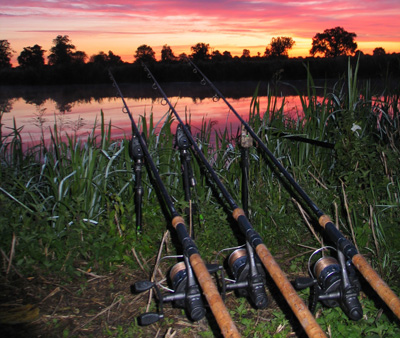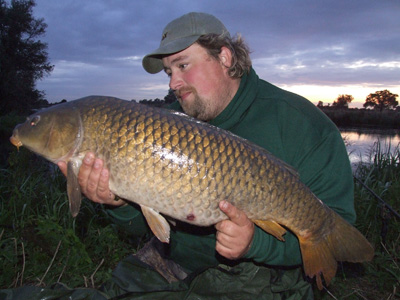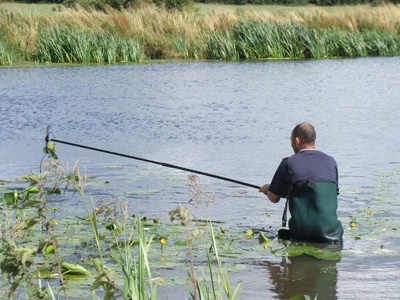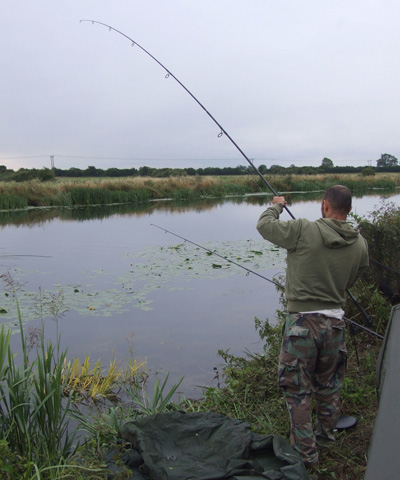Carp fishing, as we all know, has become the most popular branch of coarse angling but for many anglers the explosion of other carp anglers has become somewhat tedious. Consequently many are now looking to other challenges both within and outside of carp angling.
 I have to admit that this was indeed my position a good few years ago. I had grown up with carp being fish that were fished for by only a very few anglers and a species which were pretty difficult to catch. In fact I remember as kids one lake we used to fish we were only allowed on when there were no ‘carp men’ either on it or arriving to fish later in the day.
I have to admit that this was indeed my position a good few years ago. I had grown up with carp being fish that were fished for by only a very few anglers and a species which were pretty difficult to catch. In fact I remember as kids one lake we used to fish we were only allowed on when there were no ‘carp men’ either on it or arriving to fish later in the day.
In many ways that only went on to fuel the fire of myself and my brother wanting to catch a carp because would we not too then become one of those fabled anglers that were talked about in hushed tones – ‘carp men’?
The short answer to that one is no.
I don’t think I ever caught a carp from that particular lake, but of course as the years played out carp became a more frequent target as we learnt about, and started to fish, the gravel pits local to our home. The days of wandering around those lakes with hardly another angler in sight, or at worst two or three others, are memories to treasure indeed – especially so as that particular series of pits have long since gone along the dreaded syndicate route. Where once an Amey Anglers ticket allowed you to fish them all, to do so now would cost you several hundred pounds, some have been lost forever to re-working and others are just a shadow of their former selves, but the memories are still there and dearly treasured because in many ways I grew up there as an angler.
Many happy years pursuing carp followed those early days, fishing some lovely venues that were, to a venue, never overcrowded. However, things changed and a few years back we lost the fishing on a water that had provided me with the best fishing of my life and the next summer would see no other option but to join the rat race.
 It just never appealed to me; I had seen it on other waters my mates had fished. You know the Friday rush where everyone arrives for the weekend and the race round the lake for a swim begins. No, not for me at all and so it was that I went looking on the rivers and the drains for what I had lost elsewhere.
It just never appealed to me; I had seen it on other waters my mates had fished. You know the Friday rush where everyone arrives for the weekend and the race round the lake for a swim begins. No, not for me at all and so it was that I went looking on the rivers and the drains for what I had lost elsewhere.
It was a great move and one which saw me in very quick time take a fish the size of which few of us believed possible at the time – but size was never the most important factor – more than that it was the chance to pit man against wild fish. Fish that had no names, had probably never seen a hook before and fish that fought like tigers all the way to the net. In short it was, to me, what carp fishing had always been about and it was about as far away from the manufactured carp angling of munga mix and folded in reel handles for fashion as you could ever get.
 These days I see more and more anglers carp fishing the rivers. Thankfully nowhere near as many as you will see on a syndicate lake of a weekend, but there is definitely a rise in interest in this side of the sport. There are now big carp getting caught from all of our major river systems, the Thames, Trent, Severn, Avon and Ouse to name but a few and with the summer storms and relocations I doubt that there are many rivers in the country that don’t now have a head of carp – for better or for worse. I add that last caveat because this situation is not one of which every river angler is enamoured with and I can understand that. Carp in the wrong place can be about as an invasive a species as there is in that they don’t so much alter the numbers of fish present as a predator does, but actually alter the entire echo system by colouring up the water etc. However, the chances of this happening in the UK are pretty slim as we don’t have the climate to allow for good fry recruitment, especially in such a hostile climate as a river environment.
These days I see more and more anglers carp fishing the rivers. Thankfully nowhere near as many as you will see on a syndicate lake of a weekend, but there is definitely a rise in interest in this side of the sport. There are now big carp getting caught from all of our major river systems, the Thames, Trent, Severn, Avon and Ouse to name but a few and with the summer storms and relocations I doubt that there are many rivers in the country that don’t now have a head of carp – for better or for worse. I add that last caveat because this situation is not one of which every river angler is enamoured with and I can understand that. Carp in the wrong place can be about as an invasive a species as there is in that they don’t so much alter the numbers of fish present as a predator does, but actually alter the entire echo system by colouring up the water etc. However, the chances of this happening in the UK are pretty slim as we don’t have the climate to allow for good fry recruitment, especially in such a hostile climate as a river environment.
 So, presuming that by now I have piqued your interest in carp fishing on moving water, just how do we go about it to ensure success?
So, presuming that by now I have piqued your interest in carp fishing on moving water, just how do we go about it to ensure success?
Well, first things first, you need to determine that the river you are going to target holds carp. It may sound very basic but it’s easy to get swept along on rumour and innuendo and end up chasing after mythical fish or fishing a water where the head of carp is so small as to be unviable as a target species. To sort out the initial location you can take many directions but there is nothing better than seeing the fish themselves. On most rivers, even the more coloured ones, this is very possible as they will regularly visit the weedy margins and will roll and crash just like lake fish in the early morning or evening. I would tend to favour my observation towards evening as the water is usually at its warmest and you may get to see cruising fish.
Aside from walking the rivers you can also ask anglers that have fished it, look at reports in the angling media or chat at your local tackle shop. Be aware though that some people will massively over hype the potential of a particular venue and others may try to play down venues which are, in reality, very good so you really do need to sort out the wheat from the chaff and verify what you get told.
Once you have found a venue and hopefully spotted a few fish then you need to try to keep them in the area and hopefully pull others in too. To do this you need to pre-bait and it’s on this subject, and the subject of location, that I will look at next time in part two.













